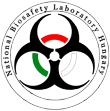{jumi [*4]}


National Biosafety Laboratory Hungary
| © National Biosafety Laboratory 2020 Minden jog fenntartva! |
Impresszum | Kapcsolat |    |


National Biosafety Laboratory Hungary
{jumi [*4]}
| © National Biosafety Laboratory 2020 Minden jog fenntartva! |
Impresszum | Kapcsolat |    |